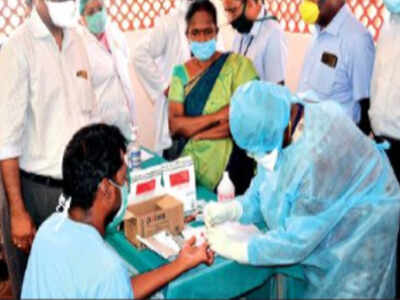
AHMEDABAD: The Ahmedabad Municipal Corporation (AMC), ostensibly to get correct addresses and phone numbers, has made it mandatory to furnish Aadhaar card details and a one-time password sent to the persons mobile, in order to get walk-in tests for Covid-19 at urban health centres. The AMC says this is because they found that 10% to 15% of such persons provided false information.
AMC says it will also help them know how many times someone was tested what the earlier results were. They said it will help eliminate a situation similar to that of Karnataka, where over 3,000 people who tested positive in Bengaluru were untraceable.
The AMC has introduced a one-time password and Aadhaar card system. As soon as the mobile number is added, the system generates a one-time password which must then be shared before the test is done.
“We wanted a foolproof patient tracking system and hence introduced the one-time password and Aadhaar card number system. It enables officers to trace the person. In one case, a couple after testing went to Pune but officials were able to locate then in Pune. In another case, a woman who tested positive on the highway was about to board a flight to the US but health workers were able to track her down,” said Rajiv Kumar Gupta, additional chief secretary, forests and environment, who is in charge of handling the Covid situation in Ahmedabad. “The patient tracking system is allowing the AMC to get accurate details,” Gupta said.
A senior officer in the health department said that in the absence of any checks or the Aadhaar card number, the person would give just a vague address. “Also, for at least 20 of every 100 tests, mobile number information was wrong. He said one patient had provided a wrong mobile number and stated his address as just ‘Behind police commissioner’s office, Shahibaug’. This person was found to be positive and calls to him were to no avail. Officials then began searching for the person and could trace him through surveillance in the area. Officers said in such cases the blame often fell on the person entering the data.
AMC says it will also help them know how many times someone was tested what the earlier results were. They said it will help eliminate a situation similar to that of Karnataka, where over 3,000 people who tested positive in Bengaluru were untraceable.
The AMC has introduced a one-time password and Aadhaar card system. As soon as the mobile number is added, the system generates a one-time password which must then be shared before the test is done.
“We wanted a foolproof patient tracking system and hence introduced the one-time password and Aadhaar card number system. It enables officers to trace the person. In one case, a couple after testing went to Pune but officials were able to locate then in Pune. In another case, a woman who tested positive on the highway was about to board a flight to the US but health workers were able to track her down,” said Rajiv Kumar Gupta, additional chief secretary, forests and environment, who is in charge of handling the Covid situation in Ahmedabad. “The patient tracking system is allowing the AMC to get accurate details,” Gupta said.
A senior officer in the health department said that in the absence of any checks or the Aadhaar card number, the person would give just a vague address. “Also, for at least 20 of every 100 tests, mobile number information was wrong. He said one patient had provided a wrong mobile number and stated his address as just ‘Behind police commissioner’s office, Shahibaug’. This person was found to be positive and calls to him were to no avail. Officials then began searching for the person and could trace him through surveillance in the area. Officers said in such cases the blame often fell on the person entering the data.

Coronavirus outbreak
Trending Topics
LATEST VIDEOS
More from TOI
Navbharat Times
Featured Today in Travel
Quick Links
Kerala Coronavirus Helpline NumberHaryana Coronavirus Helpline NumberUP Coronavirus Helpline NumberBareilly NewsBhopal NewsCoronavirus in DelhiCoronavirus in HyderabadCoronavirus in IndiaCoronavirus symptomsCoronavirusRajasthan Coronavirus Helpline NumberAditya ThackerayShiv SenaFire in MumbaiAP Coronavirus Helpline NumberArvind KejriwalJammu Kashmir Coronavirus Helpline NumberSrinagar encounter
Get the app









